Writing content that actually works is harder than it looks.
I’ve been doing this for over a decade now. And if there’s one thing I’ve learned, it’s that good writing isn’t about talent. It’s about knowing the fundamentals and practicing them until they become second nature.
This guide covers everything I wish someone had told me when I started. From crafting headlines that get clicks to editing your work like a pro.
Let’s get into it.
Related Guides:
- Content Strategy Guide for planning what to write
- SEO Writing Guide for optimizing content for search
- The Fundamentals of Good Content Writing
- Writing Headlines That Get Clicks
- Writing Introductions That Hook
- Structuring Content for Readability
- Developing Your Voice and Tone
- Writing Different Content Types
- Writing for Credibility and Trust
- The Editing Process
- Writing Faster Without Sacrificing Quality
- Using AI as a Writing Assistant
- Common Writing Mistakes to Avoid
- Content Writing Checklist
- Start Writing Better Today
The Fundamentals of Good Content Writing
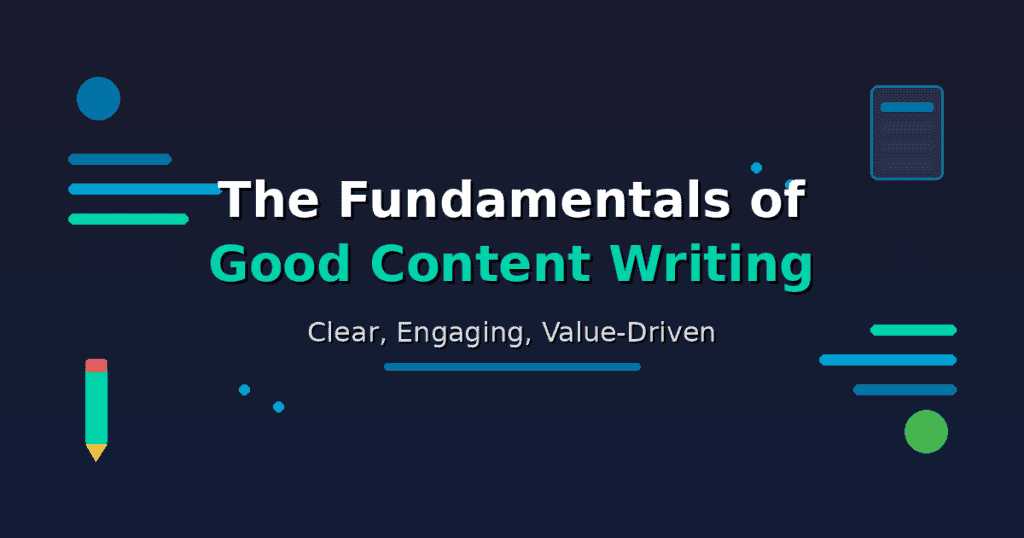
Here’s what separates good content from forgettable content.
Good writing is clear. It’s engaging. And it delivers value to the reader without wasting their time.
Your job as a writer? Make complex ideas simple. Make boring topics interesting. And make every single word earn its place on the page.
Writing for the web is different from academic or print writing. Your readers scan. They skim. They decide in seconds whether to stay or bounce.
Writing for Web Readers
Web readers don’t read. They scan in an F-pattern.
They look at headlines first. Then subheadings. Then the first sentence of each paragraph.
You have about 3 seconds to hook someone before they hit the back button.
So front-load your value. Put the most important information first. Every paragraph should earn the next scroll.
If someone can’t understand your main point from skimming, you’ve lost them.
The Reader-First Mindset
Stop writing for “audiences.” Start writing for one specific person.
When I sit down to write, I imagine I’m explaining something to a real person sitting across from me. What do they want to know? What problem are they trying to solve?
Your job is to serve the reader, not impress them with fancy vocabulary.
Empathy drives good writing. Understand where your reader is starting from, and meet them there.
Writing Headlines That Get Clicks
Here’s a stat that should scare you.
80% of people read headlines. Only 20% actually read the article.
Your headline is a promise. The content has to deliver on that promise. But if the headline doesn’t grab attention, your amazing content doesn’t matter.
Headlines do two jobs: attract clicks AND set accurate expectations. Clickbait gets the first one right and fails miserably at the second.
Headline Formulas That Work
You don’t need to reinvent the wheel here. These formats work for a reason.
Number headlines like “7 Ways to…” or “11 Mistakes That…” work because numbers attract the eye. They also set clear expectations for what the reader will get.
How-to headlines like “How to [Achieve Desired Result]” offer a clear value proposition. People know exactly what they’re getting.
Question headlines like “Are You Making These [Topic] Mistakes?” trigger curiosity. They make readers want to find out the answer.
Negative headlines like “Stop Doing [Common Mistake]” tap into loss aversion. We’re wired to avoid pain more than we seek pleasure.
Bracket headlines with [2026] or [With Examples] can boost CTR by up to 38%. They add specificity and freshness.
What Makes Headlines Click
Specificity sells.
“Increase Traffic” is boring. “Increase Organic Traffic by 47%” makes people lean in.
Your headline should be benefit-driven. What will the reader actually gain from reading your content?
Create a curiosity gap. Hint at value without giving everything away.
Use emotional triggers. Words like “proven,” “simple,” “secret,” and “mistake” grab attention.
And use second person (“you,” “your”) to make it personal. You’re talking directly to the reader, not at them.
Headline Length and Testing
Keep headlines between 55-60 characters. That’s the sweet spot for search results and social shares.
6-8 words tends to perform best for engagement.
Here’s something most writers don’t do: write 10-25 headline variations before choosing. Don’t settle on your first idea. Your best headline is rarely the first one you think of.
Test your headlines using tools like CoSchedule Headline Analyzer. Or better yet, A/B test them with real traffic.
Writing Introductions That Hook
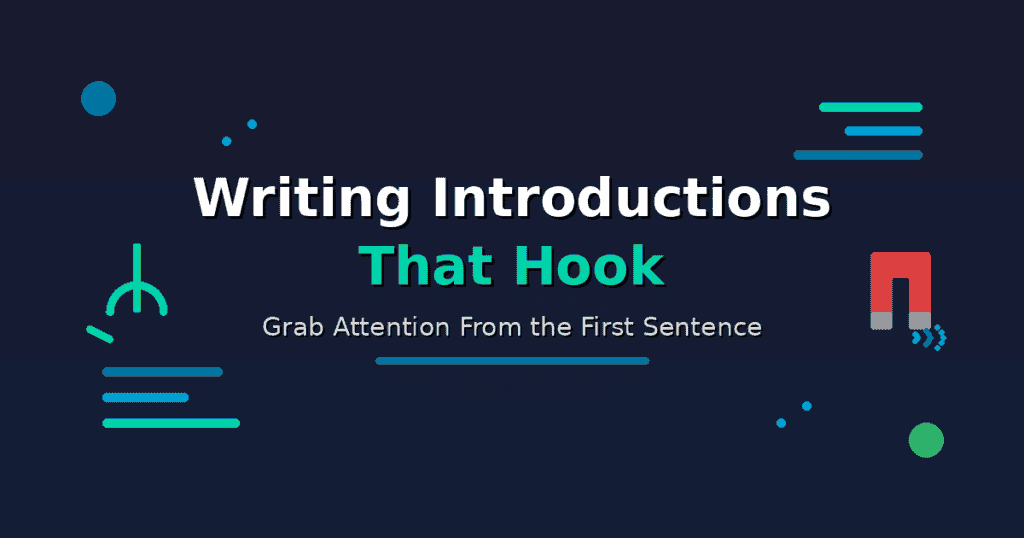
Your introduction decides whether readers stay or leave.
I’ve seen amazing content buried under boring intros. A weak opening kills even the best article.
Think of it this way: your first sentence’s only job is to make readers want the second sentence.
Introduction Frameworks
Different hooks work for different content. Here are my favorites.
PAS (Problem-Agitate-Solution) is classic for a reason. State the problem. Amplify the pain. Then hint at the solution you’re about to deliver.
Question hooks start with a question the reader desperately wants answered. It pulls them in immediately.
Story hooks open with a brief, relevant anecdote. People are wired for stories.
Statistic hooks lead with a surprising data point. Something that makes them go “wait, really?”
Bold statements challenge assumptions or promise clear value. They make people want to hear you out.
Anatomy of an Effective Introduction
Every good intro has three parts.
The hook. That’s your first 1-2 sentences that grab attention.
The bridge. This connects the hook to your topic. Show the reader you understand their situation.
The thesis. Tell readers exactly what they’ll learn and why it matters.
Keep your intros to 3-6 sentences. That’s about 100-150 words. Get to the content quickly.
Introduction Mistakes to Avoid
Please, for the love of good writing, don’t start with “In this article, I will discuss…”
It’s boring. It wastes words. And it screams amateur.
Don’t bury the lead. If readers have to scroll to find your point, they won’t.
Don’t over-promise. Setting expectations your content can’t meet destroys trust.
Cut the throat-clearing. Those warm-up sentences that add no value? Delete them.
Structuring Content for Readability
Structure isn’t just about organization.
It’s about respecting your reader’s time.
Well-structured content is scannable. It’s logical. It guides readers to exactly what they need.
Poor structure causes confusion. And confusion causes bounces.
The Inverted Pyramid
Put your most important information first.
Start with the conclusion or key takeaway. Follow with supporting details and context. End with background information and nice-to-knows.
Why? Because readers who leave early still get value. And readers who stay get the full depth.
This isn’t how we were taught to write in school. But it’s how web readers actually consume content.
Using Subheadings Effectively
Subheadings are navigation tools.
Readers should be able to understand your content from headings alone. If they can’t, your subheadings aren’t doing their job.
Make subheadings descriptive, not clever. “Why Email Beats Social” is better than “The Surprising Truth.”
Use a consistent hierarchy. H2s for main sections. H3s for subsections. Don’t skip levels.
Aim for a subheading every 200-300 words. This creates scannable chunks that don’t overwhelm readers.
Paragraph and Sentence Length
Keep paragraphs to 2-4 sentences max for web readability.
Vary your sentence length. Short sentences punch. Longer sentences explain and connect ideas.
One idea per paragraph. Don’t cram multiple concepts together.
Single-sentence paragraphs work great for emphasis. But use them sparingly, or they lose their impact.
Formatting for Scannability
Use bullet points for lists of 3+ items.
Bold key phrases to guide scanning eyes. But bold phrases, not whole sentences.
Numbered lists work well for sequences or rankings.
White space is your friend. Dense walls of text repel readers.
Break up long sections with relevant images, quotes, or callouts. Give readers’ eyes a place to rest.
Developing Your Voice and Tone

Voice is your personality as a writer.
Tone is how you adjust that personality for different contexts.
A distinctive voice makes your content memorable. It builds connection with readers. It’s what makes people come back.
Your voice should be consistent across everything you write. Tone adapts to the topic and audience.
Finding Your Writing Voice
Write like you talk. Then edit for clarity.
Read your writing aloud. Does it sound like a real person? Or does it sound like a robot trying to impress someone?
Study writers you admire. What makes their voice distinctive? Not so you can copy them, but so you can understand what works.
Let your personality show. Your opinions. Your experiences. Your humor when it’s appropriate.
Authenticity beats perfection every time. Readers connect with real humans, not polished corporate voices.
Matching Tone to Context
Different topics need different tones.
Formal topics like legal, medical, or finance content need a professional, precise approach. Be careful with claims.
Technical content should be clear and patient. Avoid jargon unless your audience expects it.
Lifestyle content can be conversational and energetic. Let your personality shine.
B2B content sits in the middle. Professional but approachable. Always focused on value.
Adjust your tone for the situation. But don’t lose your core voice in the process.
Common Voice Mistakes
Trying to sound “professional” by being stiff and impersonal is the biggest mistake I see.
You’re not writing a legal brief. You’re communicating with humans.
Overusing corporate buzzwords kills credibility. So does being so casual you lose authority.
Inconsistent voice confuses readers. If you’re formal in one section and joking in the next, something’s wrong.
And please, develop your own voice. Copying someone else’s style is obvious and uncomfortable to read.
Writing Different Content Types
Different formats need different approaches.
Master the conventions of each type first. Then put your own spin on them.
Always start by studying top-performing examples of whatever format you’re tackling.
How-To Articles and Tutorials
Start with the end result. What will readers actually achieve?
Break the process into clear, numbered steps. Each step should be one action. Not three actions crammed together.
Include what to do if something goes wrong. Real tutorials anticipate problems.
Add screenshots, examples, or visuals for complex steps.
End with what comes next. Or how to troubleshoot common issues.
I have more on this in my guide to what content writers actually do.
Listicles and Roundups
The number in your title is a promise. Deliver that exact count.
Put your strongest items early. Many readers won’t make it to the end.
Give each item roughly equal depth. Inconsistent treatment feels sloppy.
Include brief explanations, not just names. Add value beyond a simple list anyone could make.
Use consistent formatting for each item. Name, description, example, link.
Opinion and Thought Leadership
Take a clear stance.
Wishy-washy opinions are forgettable. “It depends” is not a thought leadership position.
Support your position with evidence, examples, or personal experience.
Acknowledge counterarguments. Then explain why you disagree. This builds credibility.
Share experiences that give you authority on the topic. What have you actually done or learned?
End with a call to action or discussion prompt. Get readers thinking.
Case Studies and Success Stories
Follow a clear structure: Challenge, Solution, Results.
Use specific numbers and metrics. “Increased traffic” is weak. “Increased organic traffic by 147% in 6 months” is strong.
Include direct quotes from the subject. Let them tell parts of the story.
Tell a story. Don’t just list facts.
Make the protagonist relatable to your target audience. Readers should see themselves in the case study.
End with lessons they can actually apply.
Writing for Credibility and Trust
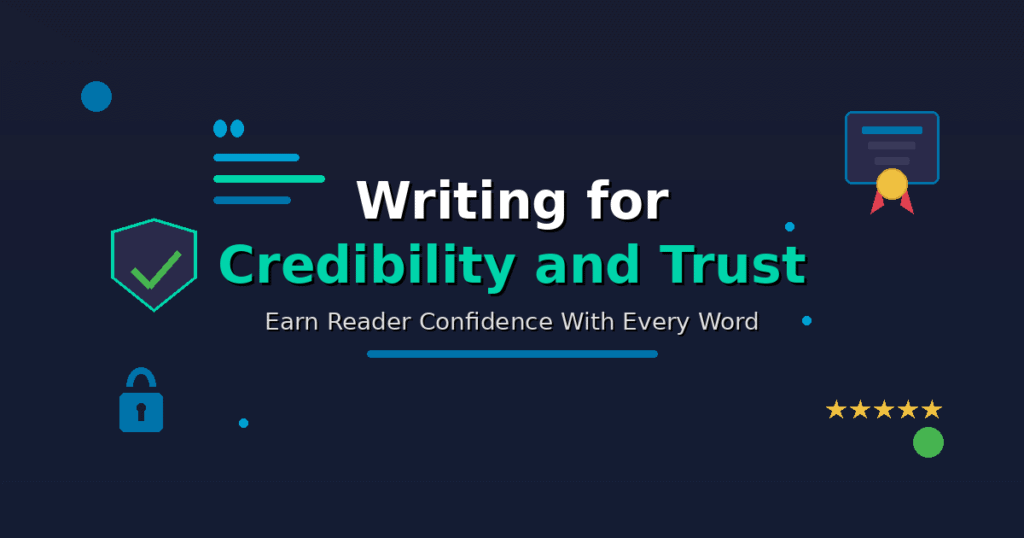
Your readers are skeptical. And they should be.
Earning trust is essential. Without it, your content doesn’t convert.
Credibility comes from accuracy, transparency, and demonstrated expertise.
Trust is built slowly over time. But it can be destroyed in an instant.
Supporting Claims with Evidence
Back up your assertions with data, research, or expert quotes.
Link to original sources. Not summaries of summaries.
Include publication dates. Old data loses credibility fast.
Be specific. “Studies show…” is weak. “A 2026 Stanford study of 10,000 users found…” is strong.
If you’re sharing your opinion, label it as such. Readers appreciate the honesty.
Demonstrating First-Hand Experience
Share what you’ve personally tested, tried, or learned.
Include screenshots, photos, or examples from your own work. This is huge for credibility.
Admit mistakes and lessons learned. Authenticity builds trust faster than pretending to be perfect.
Explain your methodology when sharing results. How did you get those numbers?
And don’t pretend to be an expert on topics where you’re not. Readers can tell.
Being Honest About Limitations
Acknowledge when something won’t work for everyone.
Include caveats where appropriate. You can do this without undermining your content.
Update content when information changes. Outdated content destroys trust.
Disclose affiliate relationships or potential conflicts. Transparency matters.
Don’t overpromise results you can’t guarantee.
The Editing Process
First drafts are supposed to be rough.
Editing is where writing actually gets good.
Professional writers spend as much time editing as writing. Sometimes more. The editing phase is where amateur content becomes professional content.
The Three Stages of Editing
Stage 1: Structural editing. Does the content flow logically? Are sections in the right order? Is anything missing? Is anything unnecessary?
Stage 2: Line editing. Does each sentence work? Is the language clear, concise, and engaging?
Stage 3: Proofreading. Are there typos, grammatical errors, or formatting issues?
Do these in order. There’s no point proofreading sentences you might delete.
Self-Editing Techniques
Wait at least a few hours before editing. Overnight is even better.
Read your work aloud. Your ear catches what your eye misses.
Print it out or change the font for a fresh perspective. This sounds weird, but it works.
Read backward, sentence by sentence, to catch errors.
Ask yourself: Can I say this in fewer words? Then cut ruthlessly.
What to Cut
Weak words: very, really, just, quite, somewhat, rather. They add nothing.
Redundancies: “past history,” “completely finished,” “free gift.” Pick one.
Throat-clearing: “It’s important to note that…” “Basically…” “In order to…” Just say the thing.
Passive voice: “The report was written” becomes “I wrote the report.” Usually stronger.
Qualifiers that weaken: “I think,” “maybe,” “sort of,” “tends to.” Either commit or cut.
Using Editing Tools
Grammarly catches grammar, spelling, and some style issues. I use it on everything.
Hemingway Editor highlights complex sentences and passive voice.
ProWritingAid gives detailed reports on style, readability, and overused words.
If you’re wondering which to choose, I have a full ProWritingAid vs Grammarly comparison.
Use tools as a starting point. Not a replacement for your judgment. They miss context and flag intentional stylistic choices as “errors.”
Writing Faster Without Sacrificing Quality
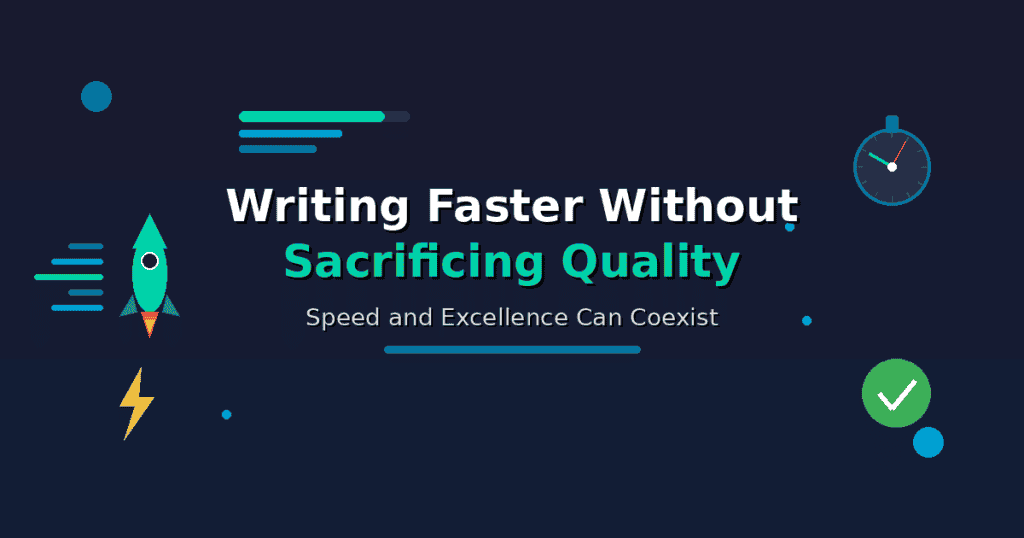
Speed comes from preparation. Not from rushing the writing itself.
Writer’s block usually means you haven’t thought enough before writing. If you’re staring at a blank screen, you’re not ready to write yet.
Establish a process. Repeat it. Consistency beats inspiration.
Preparation That Speeds Up Writing
Create a detailed outline before you start. This is the biggest time saver.
Do all your research first. Don’t stop mid-draft to look things up.
Know your main message and key takeaways before writing your first sentence.
Collect examples, data, and quotes during research. Have them ready.
Write the headline and subheadings first. They create your roadmap.
Drafting Efficiently
Write your first draft fast. Don’t edit as you go.
Switching between writing and editing kills momentum. They use different parts of your brain.
Skip sections that are hard. Come back to them later.
Set a timer. Write in focused sprints of 25-50 minutes.
Lower your standards for the first draft. It just needs to exist. You’ll fix it in editing.
Building Writing Habits
Write at the same time daily if possible. Routine beats motivation every time.
Start with the easiest section to build momentum. Don’t tackle the hardest part first.
Keep a swipe file of phrases, transitions, and examples you like.
Batch similar tasks. All outlines on Monday. All drafts on Tuesday.
Track your output. Understanding your realistic capacity helps with planning.
Using AI as a Writing Assistant
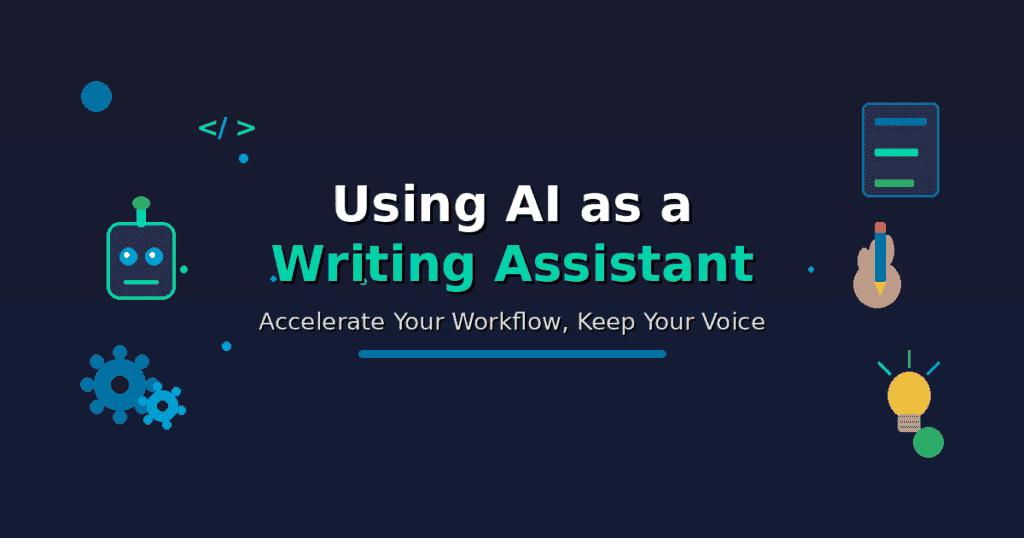
AI can accelerate certain writing tasks.
But it can’t replace human judgment. Not even close.
Best uses: ideation, outlining, research synthesis, editing assistance.
Worst uses: generating publish-ready content without heavy editing.
Where AI Helps Writers
Brainstorming headline variations and angles. AI is great for generating options.
Creating initial outlines and structures.
Summarizing research and source material.
Suggesting alternative phrasings for awkward sentences.
Checking grammar and consistency.
Generating first drafts for repetitive content like product descriptions.
I cover more of this in my Content AI guide.
Where AI Falls Short
Creating genuinely original insights. AI remixes existing ideas. It doesn’t generate new ones.
Writing with an authentic, distinctive voice. AI content sounds like AI content.
Adding personal experience and first-hand knowledge. It can’t share what it hasn’t experienced.
Understanding nuance, context, and audience sensitivity.
Fact-checking. AI confidently makes things up. Always verify.
Producing content that doesn’t feel generic. Without heavy editing, AI content is obvious.
AI Writing Best Practices
Always verify facts generated by AI. I can’t stress this enough.
Use AI output as a starting point. Never a final draft.
Inject your voice, experience, and perspective.
Don’t publish AI content without substantial human editing.
Disclose AI use where appropriate or required.
Common Writing Mistakes to Avoid
Structure Mistakes
Burying the lead. Making readers hunt for your point.
Sections that run too long without subheadings.
Logical jumps. Moving between ideas without transitions.
No clear conclusion. Content that just… stops.
Style Mistakes
Jargon and buzzwords that obscure meaning instead of clarifying.
Sentences that try to do too much.
Inconsistent tone. Formal one paragraph, casual the next.
Overusing the same transition words. “However” doesn’t need to appear 15 times.
Being clever instead of clear. Clarity always wins.
Credibility Mistakes
Making claims without evidence.
Using outdated statistics or sources.
Over-promising results.
Ignoring counterarguments or limitations.
Pretending expertise you don’t have.
If you want to improve your English writing skills, I have more on common mistakes there.
Content Writing Checklist
Before Writing
- [ ] Clear understanding of the target reader
- [ ] Main message and takeaway defined
- [ ] Outline with subheadings complete
- [ ] Research and sources gathered
- [ ] Examples and data collected
During Writing
- [ ] Strong headline that promises clear value
- [ ] Introduction hooks and previews content
- [ ] One idea per paragraph
- [ ] Subheadings every 200-300 words
- [ ] Claims supported with evidence
- [ ] Consistent voice throughout
During Editing
- [ ] Structure flows logically
- [ ] Each section earns its place
- [ ] Weak words and filler removed
- [ ] Sentences are clear and concise
- [ ] Read aloud to check rhythm
Before Publishing
- [ ] Proofread for typos and errors
- [ ] Formatting is consistent
- [ ] Links work and sources are cited
- [ ] Content delivers on headline promise
Start Writing Better Today
Good content writing isn’t magic.
It’s understanding the fundamentals. Practicing until they become habits. And always putting the reader first.
Start with one thing from this guide. Maybe it’s writing better headlines. Maybe it’s cutting weak words during editing. Maybe it’s finally creating outlines before you write.
Pick one thing. Master it. Then add the next.
That’s how you become a better writer.
Want help with your content strategy? Check out my content writing services or get in touch to discuss your project.
